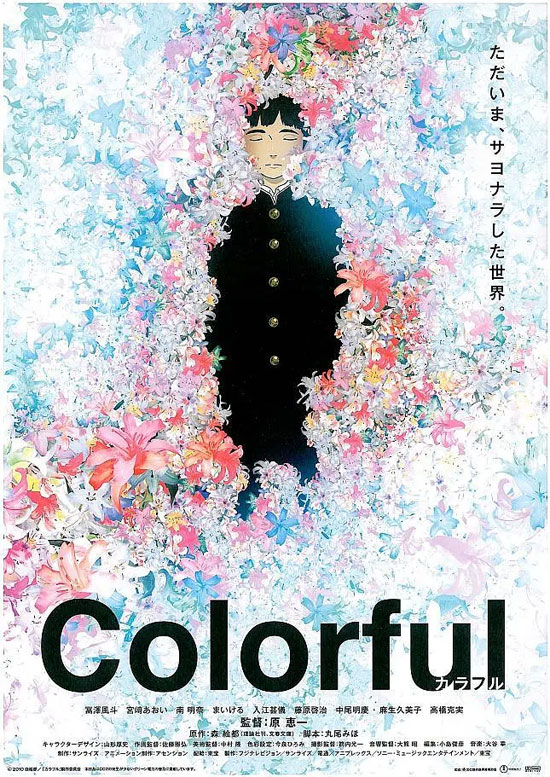Film Name: 意外的幸运签 / Karafuru / Colorful / カラフル

This is a quintessential Japanese film—its leisurely narrative pace, the rich emotional depth conveyed through understated visuals, and the surprising twist revealed only at the very end…
For those who can afford to go to the cinema, there’s always a bit of disposable income left over. That’s why they can spend money on cultural products and actively pursue a more refined lifestyle. This film is tailored precisely for such individuals. Only those whose lives are not consumed by poverty can afford the mental space to contemplate life’s deeper meanings.
Thus, I’ve always believed Japanese animated films possess an essential difference from their American counterparts. Comparatively, I prefer this style of Japanese animation. Though it may seem subdued or even taxing at times, it demands genuine engagement—unlike American animation, which often requires only superficial attention. This interactive experience of thoughtful engagement leaves you feeling enriched, rather than merely laughing a few times with nothing lasting to take away.
When protagonist Shin Kobayashi shares dinner with his family, his complex emotions—feeling both their care and his desire to live his own way—are expressed through his tears. I couldn’t help but cry too. Life is such a complex dish, like the hotpot his mother cooked, filled with everything imaginable. Father, mother, brother—each has multiple facets. No one is perfect, yet they all possess kindness, especially toward family. When this kindness flows selflessly through the invisible bond of blood, you can’t help but recall countless moments from your own life.
This anime depicts multiple family dinners, each carrying profound significance. From the initial numb gatherings, to Kobayashi Shin’s rejection of his mother’s cooking, to the eruption when that rejection reached a breaking point, and finally to acceptance… The journey a person’s heart traverses is longer than any physical path. Yet once the window paper is pierced, the distance between hearts can grow so incredibly close. It’s truly a marvel!
If you have the chance, I recommend watching another Japanese animated film, “Human Crossing,” which also explores journeys of the soul. Few people navigate psychological development without detours—sometimes veering dangerously close to the edge of death. Japan is a nation with high suicide rates, where immense mental pressure is a primary factor. This film emerged precisely against this backdrop of social reality. Kobayashi Makoto, the girl with glasses, the girl Makoto secretly loves—even his father, mother, and older brother—who among them doesn’t bear such pressure? The film aims to rewrite this harsh reality, presenting audiences with a life full of hope and vibrant colors. This perspective will undoubtedly resonate deeply with many Japanese people enduring immense psychological strain.
The only character in the film free from mental pressure is Koto, Kobayashi Makoto’s classmate, his first friend, and the person who altered the course of his soul. This character embodies a “god-like” presence throughout the film. Though ordinary in appearance and academically struggling, he possesses an open personality, a forgiving heart, and an unwavering belief in pursuing his ideals. He is one of Japan’s passionate railway enthusiasts—a culture thriving in this nation of exceptionally developed rail networks. For some, railways become a hobby akin to baseball or basketball, inspiring dedicated exploration, pursuit, and study. His journey with Kobayashi Shin to find the old site of the Tamagawa Line was, in essence, a journey to discover life’s true beauty and goodness. He became Kobayashi Makoto’s guide, transforming her inner world. In truth, living a rich life doesn’t require being a great figure—any ordinary person like Koyanagi can achieve it.
Kobayashi Makoto’s greatest talent lies in painting, a domain perfectly aligned with the film’s true title, “Colorful.” Yet initially, despite her skill, she failed to grasp the vibrant hues of life’s own painting. Only after grasping this truth did his paintings truly come to life.
The title “Colorful” carries profound resonance. While the chance to restart life may seem like a gift from heaven, is it truly a lucky charm? If life is filled with suffering—as Shinji experienced initially, where everything went wrong and everyone revealed their worst sides—what meaning would restarting hold? Would it merely mean continuing to live in pain? Through this “unexpected lucky charm,” the film seeks to convey two truths: life offers only one chance—death brings no second opportunities, no accidents; and happiness isn’t bestowed by fate, but grasped by one’s own hands—there truly exists no charm destined to bring luck to anyone.
Please specify:Anime Phone Cases » Colorful 2010 Animation Film Review: Life holds no unexpected luck.